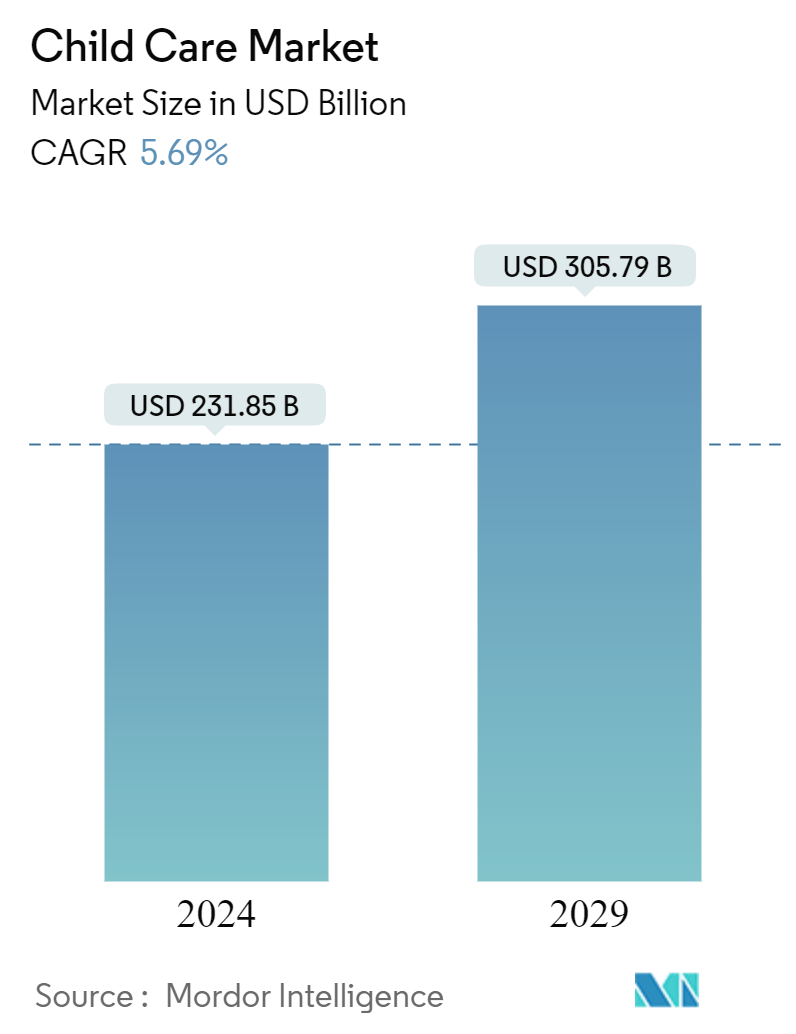Market Size of Child Care Industry

| Study Period | 2019 - 2029 |
| Market Size (2024) | USD 231.85 Billion |
| Market Size (2029) | USD 305.79 Billion |
| CAGR (2024 - 2029) | 5.69 % |
| Fastest Growing Market | Asia-Pacific |
| Largest Market | North America |
Major Players
*Disclaimer: Major Players sorted in no particular order |
Child Care Market Analysis
The Child Care Market size is estimated at USD 231.85 billion in 2024, and is expected to reach USD 305.79 billion by 2029, growing at a CAGR of 5.69% during the forecast period (2024-2029).
Factors such as the increasing number of single parents, rising demand for early childcare education, growing adoption of new learning technologies, and increasing onsite care facilities are expected to boost market growth over the forecast period.
The number of single-parent families is rising globally, increasing the demand for daycare or other childcare services for their early education and well-being owing to the difficulty in providing the required attention to the kids. This is expected to fuel the market growth over the forecast period. According to the 2022 statistics published by the United States CBS, about 57% of millennial children were born to unmarried mothers, and 15 million single-mother families were reported in the United States in the same year.
Adopting innovative techniques and tools to educate children has increased the demand for childcare services and centers, bolstering market growth. In February 2023, under the New Education Policy (NEP), childcare centers launched an activity-based learning tool, Jaadui Pitara, that allows kids to study while playing.
The rising initiatives to promote onsite childcare services and centers are expected to increase market growth over the forecast period. For instance, in August 2022, the state government of Kerala launched its new project, 'Workplace Child Care Center,' a creche in the Public Service Commission (PSC) office, to promote breastfeeding and normalize it in public spaces.
Therefore, the market is expected to grow over the forecast period due to factors such as the rising number of single-parent families, the adoption of new learning tools, and the increasing launches of onsite childcare centers. However, the high cost of childcare services and the lack of service providers are likely to impede the market's growth over the forecast period.
Child Care Industry Segmentation
As per the report's scope, child care is the caring and monitoring a child or multiple children whose ages span from two weeks to 18 years. Early childhood or elementary education may be provided as part of child care in sophisticated learning environments. Professional caregivers provide care in either a center-based setting (such as daycare centers, preschools, and schools) or at homes (nannies or family daycare).
The child care market is segmented by type, delivery type, and geography. By type, the market is sub-segmented into early care, early education, daycare, backup care, and other types. By delivery type, the market is sub-segmented into organized care facilities and home-based settings. By geography, the market is sub-segmented into North America, Europe, Asia-Pacific, the Middle East and Africa, and South America. The report also covers the estimated market sizes and trends for 17 countries across significant regions globally. The report offers the value (USD) for all the above segments.
| By Type | |
| Early Care | |
| Early Education and Daycare | |
| Backup Care | |
| Other Types (Shared Nanny, babysitter, Relative Care) |
| By Delivery Type | |
| Organized Care Facilities | |
| Home-based Settings |
| Geography | ||||||||
| ||||||||
| ||||||||
| ||||||||
| ||||||||
|
Child Care Market Size Summary
The childcare market is poised for substantial growth over the forecast period, driven by several key factors. The increasing number of single-parent families globally is a significant contributor, as these families often require daycare and other childcare services to support early education and child well-being. Additionally, the rising demand for early childcare education and the adoption of innovative learning technologies are further propelling market expansion. The introduction of new learning tools, such as activity-based learning programs, and the promotion of onsite childcare facilities are also expected to enhance market dynamics. Despite these growth drivers, challenges such as the high cost of childcare services and a shortage of service providers may impede market progress.
Regionally, North America is anticipated to maintain a significant share of the childcare market, supported by a high demand for early daycare and education services, a substantial number of single-parent families, and robust government initiatives. The region's market growth is further bolstered by funding and programs aimed at improving access to quality childcare and supporting early childhood educators. The market landscape is characterized by fragmentation, with both large and small players actively participating. Key industry participants include Bright Horizons Family Solutions Inc., KinderCare Education, and Learning Care Group Inc., among others. These companies, along with government support and innovative educational offerings, are expected to drive the market's growth trajectory over the coming years.
Child Care Market Size - Table of Contents
-
1. MARKET DYNAMICS
-
1.1 Market Overview
-
1.2 Market Drivers
-
1.2.1 Increasing Number of Single Parent
-
1.2.2 High Demand for Child Care and Early Education as well as Adoption of New Learning Technologies
-
1.2.3 Increasing Onsite Care Facilities
-
-
1.3 Market Restraints
-
1.3.1 High Service Cost
-
1.3.2 Lack of Service Providers
-
-
1.4 Porter's Five Forces Analysis
-
1.4.1 Bargaining Power of Buyers/Consumers
-
1.4.2 Bargaining Power of Suppliers
-
1.4.3 Threat of New Entrants
-
1.4.4 Threat of Substitute Products
-
1.4.5 Intensity of Competitive Rivalry
-
-
-
2. MARKET SEGMENTATION (Market Size by Value - USD)
-
2.1 By Type
-
2.1.1 Early Care
-
2.1.2 Early Education and Daycare
-
2.1.3 Backup Care
-
2.1.4 Other Types (Shared Nanny, babysitter, Relative Care)
-
-
2.2 By Delivery Type
-
2.2.1 Organized Care Facilities
-
2.2.2 Home-based Settings
-
-
2.3 Geography
-
2.3.1 North America
-
2.3.1.1 United States
-
2.3.1.2 Canada
-
2.3.1.3 Mexico
-
-
2.3.2 Europe
-
2.3.2.1 Germany
-
2.3.2.2 United Kingdom
-
2.3.2.3 France
-
2.3.2.4 Italy
-
2.3.2.5 Spain
-
2.3.2.6 Rest of Europe
-
-
2.3.3 Asia-Pacific
-
2.3.3.1 China
-
2.3.3.2 Japan
-
2.3.3.3 India
-
2.3.3.4 Australia
-
2.3.3.5 South Korea
-
2.3.3.6 Rest of Asia-Pacific
-
-
2.3.4 Middle East and Africa
-
2.3.4.1 GCC
-
2.3.4.2 South Africa
-
2.3.4.3 Rest of Middle East and Africa
-
-
2.3.5 South America
-
2.3.5.1 Brazil
-
2.3.5.2 Argentina
-
2.3.5.3 Rest of South America
-
-
-
Child Care Market Size FAQs
How big is the Child Care Market?
The Child Care Market size is expected to reach USD 231.85 billion in 2024 and grow at a CAGR of 5.69% to reach USD 305.79 billion by 2029.
What is the current Child Care Market size?
In 2024, the Child Care Market size is expected to reach USD 231.85 billion.

